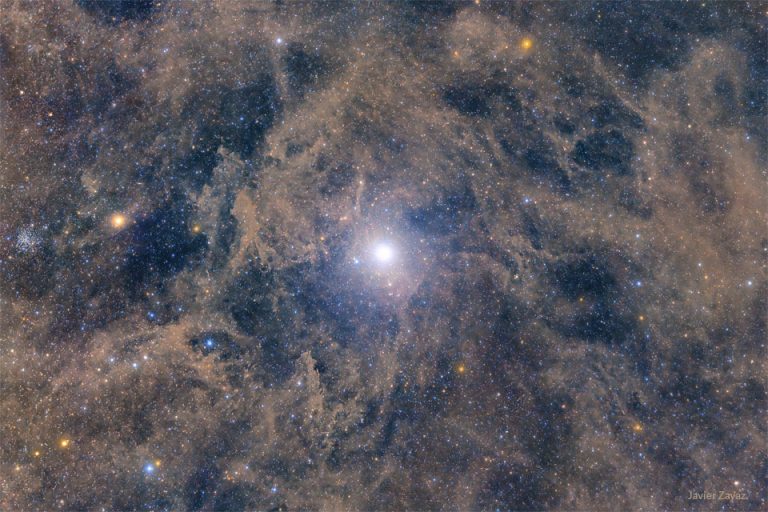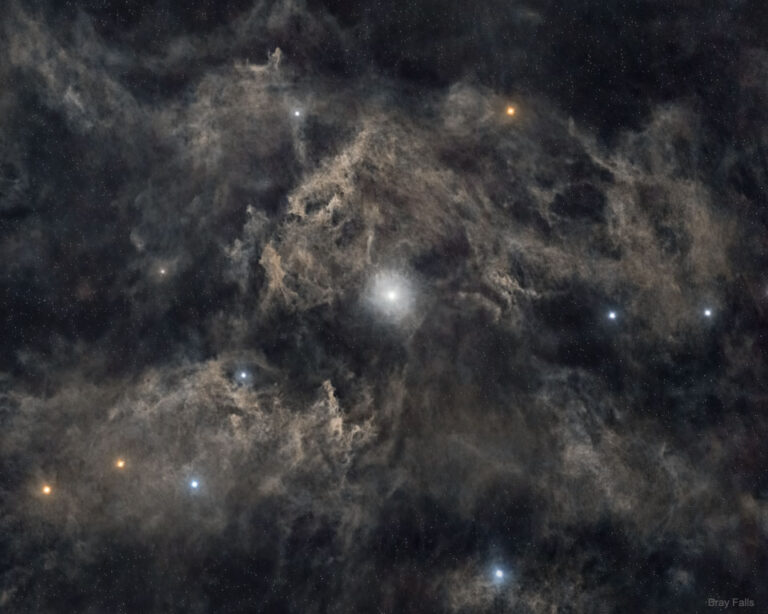指北星: 北极星及其周围的尘埃
A bright star is pictured in the center of field filled with glowing gas and dust and other, more faint, stars. Please see the explanation for more detailed information.
图像中央是一颗明亮的恒星,周围充满发光的气体和尘埃,以及其他较暗的恒星。有关更多详细信息,请参阅说明。

A bright star is pictured in the center of field filled with glowing gas and dust and other, more faint, stars. Please see the explanation for more detailed information.
图像中央是一颗明亮的恒星,周围充满发光的气体和尘埃,以及其他较暗的恒星。有关更多详细信息,请参阅说明。

请参阅说明。单击图片将下载可用的最高分辨率版本。

2023年4月11日 North Star: Polaris and Surrounding Dust Image Credit & Copyright: Javier Zayaz Explanation: Why is Polaris called the North Star? First, Polaris is the nearest bright star toward the north spin axis of the Earth. Therefore, as the Earth turns, stars appear to revolve around Polaris, but Polaris itself always stays in the same northerly direction — making it the North Star. Since no bright star is near the south spin axis of the Earth, there is currently no bright South Star. Thousands of years ago, Earth’s spin axis pointed in a slightly different direction so that Vega was the North Star. Although Polaris is not the brightest star on the sky, it is easily located because it is nearly aligned with two stars…

2023年2月3日 Polaris and the Trail of Comet ZTF Image Credit & Copyright: David Ibarra Gomez Explanation: Stars trace concentric arcs around the North Celestial Pole in this three hour long night sky composite, recorded with a digital camera fixed to a tripod on January 31, near Àger, Lleida, Spain. On that date Comet C/2022 E3 (ZTF) was near its northernmost declination in planet Earth’s sky. That put the comet about 10 degrees from Earth’s North Celestial Pole making the comet’s position circumpolar, always above the horizon, from all locations on planet Earth at more than 10 degrees northern latitude. In the startrail image, the extension of Earth’s axis of rotation into space is at the left. North star Polaris traces the short, bright, concentric arc…

2022年7月28日 North Celestial Tree Image Credit & Copyright: Jeff Dai (TWAN) Explanation: An ancient tree seems to reach out and touch Earth’s North Celestial Pole in this well-planned night skyscape. Consecutive exposures for the timelapse composition were recorded with a camera fixed to a tripod in the Yiwu Desert Poplar Forests in northwest Xinjiang, China. The graceful star trail arcs reflect Earth’s daily rotation around its axis. By extension, the axis of rotation leads to the center of the concentric arcs in the night sky. Known as the North Star, bright star Polaris is a friend to northern hemisphere night sky photographers and celestial navigators alike. That’s because Polaris lies very close to the North Celestial Pole on the sky. Of course it can be…

2021年04月28日 North Star: Polaris and Surrounding Dust Image Credit & Copyright: Bray Falls Explanation: Why is Polaris called the North Star? First, Polaris is the nearest bright star toward the north spin axis of the Earth. Therefore, as the Earth turns, stars appear to revolve around Polaris, but Polaris itself always stays in the same northerly direction — making it the North Star. Since no bright star is near the south spin axis of the Earth, there is currently no South Star. Thousands of years ago, Earth’s spin axis pointed in a slightly different direction so that Vega was the North Star. Although Polaris is not the brightest star on the sky, it is easily located because it is nearly aligned with two stars in…